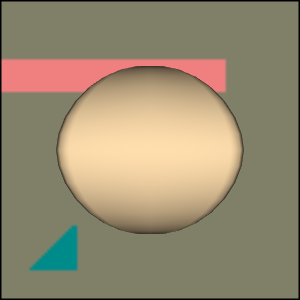BackgroundImage
Repository source: BackgroundImage
Description¶
This example displays an image as the "background" of a scene, and renders a superquadric in front of it.
The example accepts a jpeg file on the command line to use as a background image. If there is no file, it generates a simple background.
Question
If you have a question about this example, please use the VTK Discourse Forum
Code¶
BackgroundImage.py
#!/usr/bin/env python3
from dataclasses import dataclass
# noinspection PyUnresolvedReferences
import vtkmodules.vtkInteractionStyle
# noinspection PyUnresolvedReferences
import vtkmodules.vtkRenderingOpenGL2
from vtkmodules.vtkCommonColor import vtkNamedColors
from vtkmodules.vtkFiltersSources import vtkSuperquadricSource
from vtkmodules.vtkIOImage import vtkJPEGReader
from vtkmodules.vtkImagingSources import vtkImageCanvasSource2D
from vtkmodules.vtkRenderingCore import (
vtkActor,
vtkImageSlice,
vtkImageSliceMapper,
vtkPolyDataMapper,
vtkRenderWindow,
vtkRenderWindowInteractor,
vtkRenderer
)
def get_program_parameters():
import argparse
description = 'Add a background image to a render window.'
epilogue = '''
Add a background image to a render window.
'''
parser = argparse.ArgumentParser(description=description, epilog=epilogue)
parser.add_argument('-f', '--filename', default=None,
help='An optional filename e.g. Gourds2.jpg.')
args = parser.parse_args()
return args.filename
def main():
colors = vtkNamedColors()
# Verify input arguments0
fn = get_program_parameters()
if fn:
# Read the image.
jpeg_reader = vtkJPEGReader(file_name=fn)
if not jpeg_reader.CanReadFile(fn):
print('Error reading file:', fn)
return
image_data = jpeg_reader.update().output
else:
canvas_source = vtkImageCanvasSource2D(extent=(0, 100, 0, 100, 0, 0), number_of_scalar_components=3,
scalar_type=ImageCanvasSource2D.ScalarType.VTK_UNSIGNED_CHAR)
# Do the drawing.
canvas_source.draw_color = colors.GetColor4ub('warm_grey')
canvas_source.FillBox(0, 100, 0, 100)
canvas_source.draw_color = colors.GetColor4ub('DarkCyan')
canvas_source.FillTriangle(10, 10, 25, 10, 25, 25)
canvas_source.draw_color = colors.GetColor4ub('LightCoral')
canvas_source.FillTube(75, 75, 0, 75, 5.0)
image_data = canvas_source.update().output
# Create an image actor to display the image.
image_mapper = vtkImageSliceMapper()
image_slice = vtkImageSlice(mapper=image_mapper)
image_data >> image_mapper
# Create a superquadric
superquadric_source = vtkSuperquadricSource(phi_roundness=1.1, theta_roundness=0.2)
# Create a mapper and actor
superquadric_mapper = vtkPolyDataMapper()
superquadric_actor = vtkActor(mapper=superquadric_mapper)
superquadric_actor.property.color = colors.GetColor3d('NavajoWhite')
superquadric_source >> superquadric_mapper
# Set up the render window and renderers such that there is
# a background layer and a foreground layer
# Create a renderer to display the image in the background.
background_renderer = vtkRenderer(layer=0, interactive=False)
# Render the scene in the next layer.
scene_renderer = vtkRenderer(layer=1)
# Add actors to the renderers
scene_renderer.AddActor(superquadric_actor)
background_renderer.AddActor(image_slice)
render_window = vtkRenderWindow(window_name='BackgroundImage', number_of_layers=2)
render_window.AddRenderer(background_renderer)
render_window.AddRenderer(scene_renderer)
render_window_interactor = vtkRenderWindowInteractor()
render_window_interactor.render_window = render_window
# Render once to figure out where the background camera will be.
render_window.Render()
# Set up the background camera to fill the renderer with the image.
origin = image_data.origin
spacing = image_data.spacing
extent = image_data.extent
camera = background_renderer.active_camera
camera.ParallelProjectionOn()
xc = origin[0] + 0.5 * (extent[0] + extent[1]) * spacing[0]
yc = origin[1] + 0.5 * (extent[2] + extent[3]) * spacing[1]
# xd = (extent[1] - extent[0] + 1) * spacing[0]
yd = (extent[3] - extent[2] + 1) * spacing[1]
d = camera.distance
camera.parallel_scale = 0.5 * yd
camera.focal_point = (xc, yc, 0.0)
camera.position = (xc, yc, d)
# Render again to set the correct view.
render_window.Render()
# Interact with the window.
render_window_interactor.Start()
@dataclass(frozen=True)
class ImageCanvasSource2D:
@dataclass(frozen=True)
class ScalarType:
VTK_CHAR: int = 2
VTK_UNSIGNED_CHAR: int = 3
VTK_SHORT: int = 4
VTK_UNSIGNED_SHORT: int = 5
VTK_INT: int = 6
VTK_UNSIGNED_INT: int = 7
VTK_LONG: int = 8
VTK_UNSIGNED_LONG: int = 9
VTK_FLOAT: int = 10
VTK_DOUBLE: int = 11
if __name__ == '__main__':
main()
